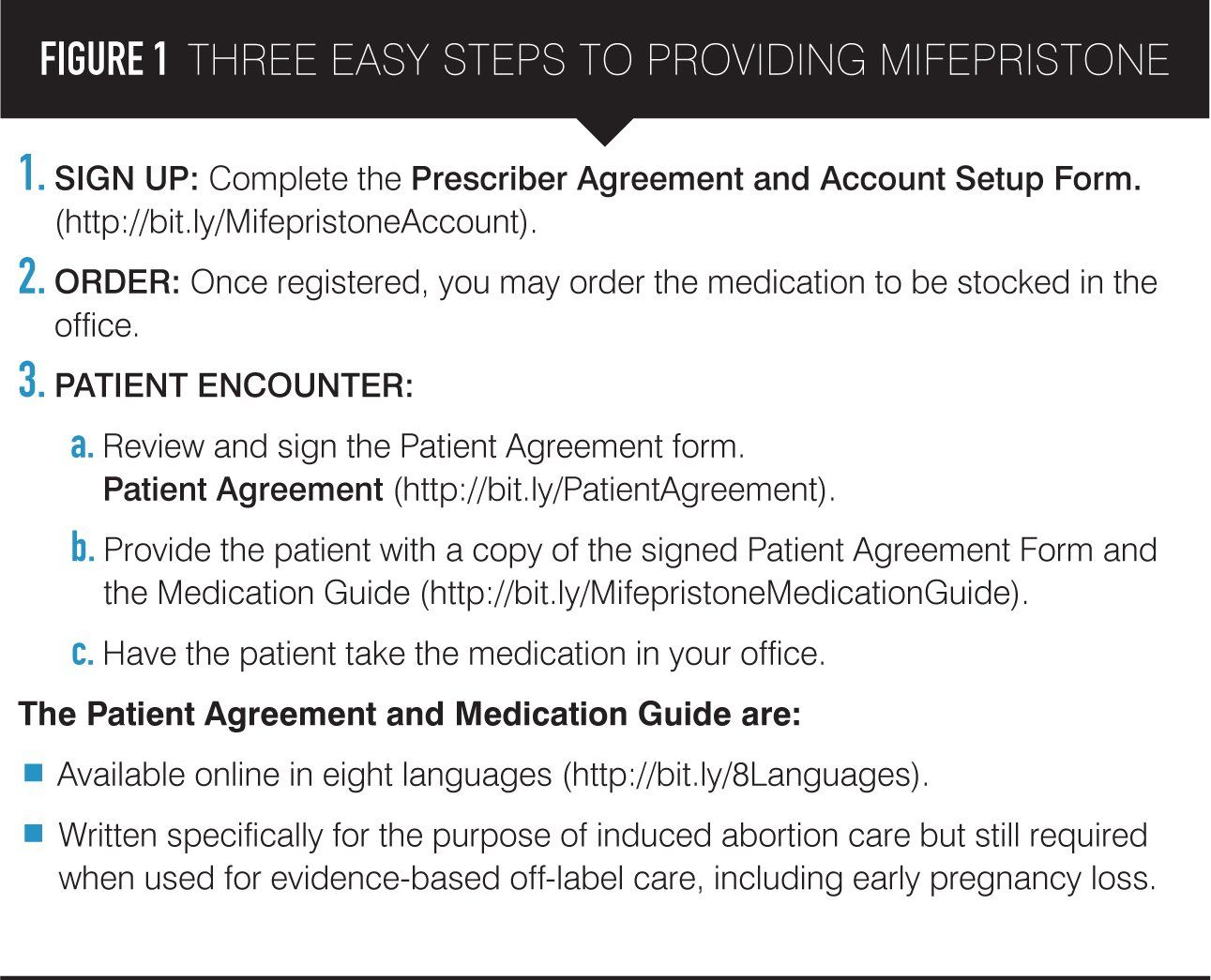Mifepristone and misoprostol: Medical management of missed abortion
Adding mifepristone to an ob/gyn’s armamentarium isn’t as easy as writing a prescription but women need access to this drug for missed abortion.
©s_l - adobe.stock.com

Figure 1

Early pregnancy loss (EPL)-including missed, incomplete and inevitable abortion-is a common clinical outcome, experienced by approximately 1 million women every year.1 Currently, management of EPL includes expectant, medical and surgical options. Previous literature demonstrated that misoprostol, a prostaglandin E1 analogue, is most effective in patients diagnosed with incomplete or inevitable abortion, and especially in those who present with symptoms such as cramping and bleeding.2 However many women are diagnosed with EPL by ultrasound, prior to onset of symptoms. Among women diagnosed with anembryonic gestation and embryonic or fetal demise, in which symptoms of EPL are less common, a single dose of misoprostol will effectively complete an abortion in only 81% to 88%, respectively. A second dose of misoprostol can increase the rate of expulsion3 but this delay in success is associated with increased costs to both patients and the health care system, including more office visits, ultrasound examinations, and patient anxiety. While medical management with misoprostol is an important alternative option to observation or a surgical procedure, we’ve all had patients for whom medical management resulted in a prolonged and frustrating process during a sensitive time. Wouldn’t it be great if we had a medical option that resulted in a more expeditious and safer resolution of pregnancy loss?
New evidence for better medical management
In “Mifepristone Pretreatment for the Medical Management of Early Pregnancy Loss” (New England Journal of Medicine, June 2018), Schreiber et al presented results of a randomized clinical trial involving 300 women who were confirmed to have a nonviable intrauterine pregnancy by 12 weeks estimated gestational age (EGA).4 Given the known high efficacy of misoprostol for patients already diagnosed with incomplete or inevitable abortions, only patients with missed abortions were included.
Participants were randomized to either pretreatment with 200 mg of oral mifepristone followed in 12 to 24 hours by 800 mcg of vaginal misoprostol, or 800 mcg of vaginal misoprostol alone, the established standard of care. The primary outcome was treatment success, as defined by expulsion of the gestational sac by the follow-up visit and no need for any additional surgical or medical intervention within 30 days of treatment. (It is worth noting the patient-focused and clinically relevant choice of primary outcome: expeditious resolution of EPL by the first follow-up visit, without need for further intervention.)
As noted by that journal in June, the results were unequivocally in favor of pretreatment with mifepristone: 84% of patients in the mifepristone pretreatment group had treatment success compared to only 67% of women given misoprostol only. The number needed to treat (NNT) was six-low by any standard. Mifepristone pretreatment also reduced the need for additional surgical intervention: by 30 days, 24% of women in the misoprostol-alone group underwent surgical treatment compared to only 9% of women in the pretreatment group. In other words, women who did not receive mifepristone had a 3-fold risk of needing additional surgical intervention via uterine aspiration.
Importantly, complications were rare in both groups. Among women in the pretreatment group, 2% required blood transfusion and 1.3% were diagnosed with a pelvic infection – rates similarly infrequent among women who received only misoprostol, as well as among those who underwent surgical management. Side effects reported by women in both arms were also similar, although vomiting was more common among those who received pretreatment with mifepristone (27% versus 15%, P= 0.01). Thanks to Schrieber et al, we can now confidently conclude that pretreatment with mifepristone prior to administration of vaginal misoprostol is safe and superior to treatment with vaginal misoprostol alone. This regimen is the new standard of care for women who choose medical management of missed abortion.
Incorporating the evidence into your practice
For ob/gyns who are not familiar with mifepristone, making it available to patients requires more than simply writing a prescription. At the time of its approval in 2000, significant restrictions were placed on mifepristone’s availability-restrictions that, 18 years later, our best science does not support.
Mifepristone is regulated by the US Food and Drug Administration (FDA) with Risk Evaluation and Mitigation Strategy (REMS) and Elements to Assure Safe Use (EASU) requirements in order to be prescribed and dispensed. Regulations such as REMS and EASU are intended to apply to drugs that have been shown to cause serious adverse effects, such as antipsychotic medications that may lead to severe neutropenia and even death. Such restrictions are not intended to apply to low-risk drugs, such as erectile dysfunction medications, which are associated with death in only 0.004% of users.
Why then would mifepristone – with a mortality rate of six times less than Viagra5– require a REMS restriction?
Strangely, mifepristone has never been shown to pose risks warranting REMS. This was evidenced recently by the FDA, which in 2016 approved an updated label for the drug that, among other things, removed language that the prescribed must be a physician and eliminated the requirement to report nonfatal adverse events. And yet, this requirement prevents prescription sales in retail pharmacies. In other words, patients who need mifepristone-for any indication or reason, be it a medical abortion, medical management of EPL or uterine fibroids6 -must find a clinician who stocks mifepristone in the office.
This is not an easy task. According to Danco, the manufacturer of Mifeprex, only 7% of sales nationwide were to private medical practices.7 Reluctance to stock the drug is thought to be widespread and reasons may include concerns about ordering, managing and dispensing a drug; costs (both of drug as well as related to wasted doses due to expiration prior to use); the burden of excessive paperwork; and, of course, stigma associated with use of mifepristone for induced medical abortion. All these factors jeopardize women’s access to our profession’s evidence-based standards of care.
Now we have yet another reason to make mifepristone more accessible to our patients. For ob/gyns who are seeking concrete steps to incorporate this new evidence into practice, please refer to Figure 1 for access to the required forms.
Some additional tips for success:
- Don’t forget contraception counseling! According to recent research by Flink-Bochacki et al., women who experience spontaneous miscarriage are receptive to the idea of contraceptive counseling, but providers are inconsistent about offering it.8 For patients choosing medical management of EPL who desire immediate contraception (and especially for whom follow-up is challenging), consider starting contraception-be it pills, Depo Provera or Nexplanon-at the time of mifepristone initiation.
- Write for an antiemetic! Authors noted an increased risk of nausea among women who received pretreatment with mifepristone. Consider providing a prescription for an antiemetic at time of treatment initiation.
A call to action
Studies of use of mifepristone for both induced abortion and medical treatment of EPL have not demonstrated risks that support REMS regulation. In addition, recent research by Raifman et al. indicates that in countries where pharmacies have been allowed to dispense mifepristone, women enjoy increased access to evidence-based medical care without increased risks to their health.9,10 Indeed, our colleagues at the American College of Obstetricians and Gynecologists (ACOG) have advocated for removing the REMS restrictions from mifepristone provision for years.11-13
Put bluntly, we must not let abortion stigma prevent women from having access to the most effective therapy for a reproductive life event as common as miscarriage. Let’s join our colleagues at ACOG in exerting pressure on the FDA to remove a requirement that impedes our ability to provide safe, timely, evidence-based care. To make your voice heard, consider contacting the FDA yourself using their Health Professionals webpage. Our patients deserve access to the new gold standard in reproductive health care, not restrictions that harm them.
Disclosures:
The authors report no potential conflicts of interest with regard to this article.
References:
1. Ventura SJ, Curtin SC, Abma JC, Henshaw SK. Estimated pregnancy rates and rates of pregnancy outcomes for the United States, 1990-2008. Natl Vital Stat Rep. 2012; 60: 1-21.
2. Creinin MD, Huang X, Westhoff C, Barnhart, K, Gilles JM Zhang J, & National Institute of Child Health and Human Development Management of Early Pregnancy Failure Trial. Factors related to successful misoprostol treatment for early pregnancy failure. Obstet Gynecol, 2006;107(4):901–907.
3. Zhang J, Gilles JM, Barnhart K, Creinin MD, Westhoff C, Frederick MM. A comparison of medical management with misoprostol and surgical management for early pregnancy failure. National Institute of Child Health Human Development (NICHD) Management of Early Pregnancy Failure Trial. N Engl J Med. 2005;353:761–9.
4. Schreiber CA, Creinin MD, Atrio J, Sonalkar S, Ratcliffe SJ, et al. Mifepristone pretreatment for the medical management of early pregnancy loss. N Engl J Med. 2018;378:2161-2170.
5. Mifeprex REMS Study Group. Sixteen years of overregulation: time to unburden Mifepres. N Engl J Med. 2017;376:8.
6. Sohn GS, Cho S, Kim YM, Cho C-H, Kim M-R, Lee SR, & Working Group of Society of Uterine Leiomyoma. Current medical treatment of uterine fibroids. Obstet Gynecol Sci, 2018;61(2):192–201.
7. McCullough M. “Doctors urge FDA to loosen restriction on abortion pill.” Philadelphia Inquirer, February 23, 2017. http://www.philly.com/philly/health/Doctors-urge-FDA-to-loosen-restrictions-on-abortion-pill.html?arc404=true
8. Flink-Bochacki R, Hamm ME, Borrero S, Chen BA, Achilles SL, Chang JC. Family planning and counseling desires of women who have experienced miscarriage. Obstet Gynecol, 2018;131(4):625–631.
9. Raifman et al. “Medication abortion: Potential for improved patient access through pharmacies.” J Am Pharm Assoc. July-Aug 2018.
10. Mifeprex REMS Study Board. “Sixteen Years of Overregulation: Time to Unburden Mifeprex.” NEJM. February 2017.
11. “Food and Drug Administration: Information on Mifeprex Labeling Changes and Ongoing Monitoring Efforts.” United States Government Accountability Office, Report to Congressional Requesters, No. 18-292. https://www.gao.gov/assets/700/691750.pdf
12.“ACOG Statement on Medication Abortion.” American College of Obstetricians and Gynecologists. March 30, 2016. https://www.acog.org/About-ACOG/News-Room/Statements/2016/ACOG-Statement-on-Medication-Abortion
13. “Improving Access to Mifepristone for Reproductive Health Indications.” American College of Obstetricians and Gynecologists. June 2018. https://www.acog.org/Clinical-Guidance-and-Publications/Position-Statements/Improving-Access-to-Mifepristone
